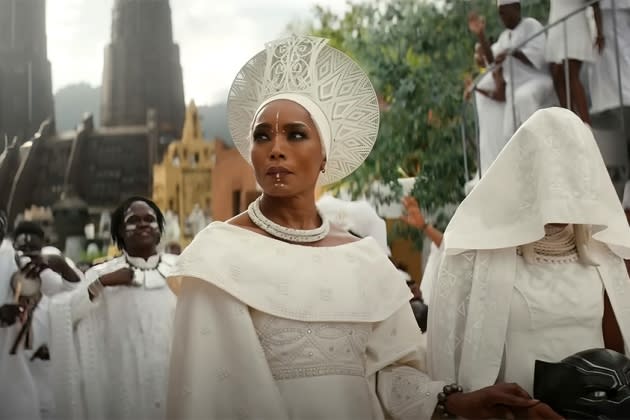Ludwig Göransson on His Globe-Trotting Odyssey to Create the ‘Wakanda Forever’ Score
- Oops!Something went wrong.Please try again later.
- Oops!Something went wrong.Please try again later.
- Oops!Something went wrong.Please try again later.

Creating the music for “Black Panther: Wakanda Forever” took composer Ludwig Göransson to Mexico, Nigeria, London and back, and involved an estimated 2,500 hours of recording.
“It was a more emotional experience than I’ve ever had on any project,” the Swedish-born musician tells Variety. Göransson won an Oscar for the first “Black Panther” movie and since then has also won two Emmys for “The Mandalorian” and a pair of Grammys as songwriter and producer for Childish Gambino.
More from Variety
“Wakanda” was something else, however. Göransson and director Ryan Coogler are old friends (this is their fourth film together) and the composer had even read Coogler’s sequel script that had been written for Chadwick Boseman to reprise his T’Challa character before the actor’s tragic death in 2020.
The challenge, Göransson says, was to find a new sound for the African kingdom of Wakanda and its grief-stricken people while also trying to imagine the sound of Prince Namor’s undersea kingdom of Talokan, whose origins lay in Mexico’s ancient Mayan civilization.
Göransson consulted musical archaeologists and spent two weeks in Mexico City collaborating with Mexican musicians. He auditioned “hundreds of ancient instruments,” from clay flutes to unusual percussion instruments, and saw paintings of Mayans playing on turtle shells, among dozens of similar musically inspirational moments. He discovered the “flute of truth,” a high-pitched whistle-like woodwind instrument, and vowed to incorporate the “death whistle,” which has a piecing sound like a human scream.
By day, Göransson recorded with Mexican musicians, and by night, he was recording with Mexican singers and rappers. “I was using the morning sessions to put together beats and songs that we would use later that day with the artists,” the composer reports.
That turned out to be the beginning of what Göransson describes as an attempt “to create a complete, immersive sound and music experience for the viewer” whereby songs and score are seamlessly intertwined throughout the film. Of the 16 songs in the film, Göransson co-wrote and produced 13 of them, including the Rhianna-performed end-title song “Lift Me Up.”
During shooting, the composer visited the set to supervise the musical aspects of T’Challa’s funeral procession, which feature Senegalese singer Baaba Mal and talking-drum player Massamba Diop, whose unique African sounds made such a crucial contribution to the original “Black Panther” score.
When filming was complete, director Coogler accompanied Göransson to Lagos, Nigeria, for another two weeks of finding and collaborating with African musicians, singers and rappers. “It’s a musical hotspot for both traditional and contemporary music,” the composer says. “Musicians brought different instruments, different sounds, that we didn’t have in the first movie, that we could add to the spirit of Wakanda.
“Both in Mexico and Nigeria we were creating music based on the script, the story, and conversations with Ryan,” Göransson adds. “When we got back to L.A., it was time to put it up to the picture and see what works. That was the challenge – and the fun part.”
The kora, a West African stringed instrument that sounds like a lute or a harp, became a key element of the score, as did traditional African drums like the sabar and djembe. Unusual flutes and the sounds of seashells added to the evocative sounds of Talokan. And modern synthesizers figure in the theme for Shuri (Letitia Wright), the tech-minded Wakandan princess who steps up in the wake of his brother’s death and the threat to her country.
The composer spent more than a year on the score overall, and estimates that 250 musicians and singers were involved, including an 80-piece London orchestra, 40-voice choirs in both London and Los Angeles, plus another 20-voice L.A. choir that specialized in Mesoamerican music.
And that’s not even counting the many singers he engaged. “This score is very, very driven by vocals,” Göransson points out. He asked Nigerian singer-songwriter Tems to lend her voice to songs and score; discovered Foudeqush and her “fantastical” voice in Mexico; and found a community of Mayan rappers in the Yucatan whose “Laayli’ kuxa’ano’one” is heard under the end titles.
As for Rhianna’s “Lift Me Up,” that song began when Coogler and Göransson landed in Lagos. The composer had a musical idea, asked Coogler to pen some lyrics, and a few months later Rhianna and Tems added their voices to the mix.
The composer is currently finishing work on Christopher Nolan’s next film “Oppenheimer,” and Disney Plus has unveiled a new animated short, “Zen: Grogu and Dust Bunnies,” with a Göransson score (a spinoff from the composer’s “Mandalorian” series for Lucasfilm).
Best of Variety
Sign up for Variety’s Newsletter. For the latest news, follow us on Facebook, Twitter, and Instagram.
